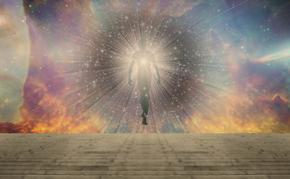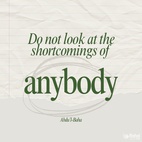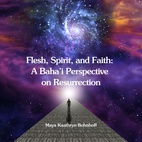The views expressed in our content reflect individual perspectives and do not represent the authoritative views of the Baha'i Faith.
Before I discovered the Baha’i Faith and became a Baha’i, I grew up as a Christian youth who enthusiastically participated in the activities of our local Baptist Church.
Besides Sunday morning worship services and Wednesday night Christian fellowship, we held our own events: hikes, cookouts, track, and other fun events designed to cultivate a personal relationship with Jesus Christ. As a group we supported each other and became fast friends. Convinced that salvation rested on accepting Christ as my personal savior, I confessed his saving grace by being baptized before the congregation.
Growing into young adulthood, I remember how the thought of death troubled me. When Christ returned, I was convinced, he would raise the dead, in what I would later know as “the Rapture.” That seemed comforting, because the thought of being interred under the dirt in a closed casket for years if not centuries unsettled me.
The Prophecies of Christ’s Second Coming
As Baptists, we had read in verse 24 of Mathew that Christ’s second coming would be preceded by a tribulation period: wars, rumors of wars, nations against nations, famine pestilence, earthquakes. Living in the turbulent 1960s, we felt sure Christ’s advent was imminent. In those days, nuclear confrontation appeared frighteningly real between the U.S. and Russia as President Kennedy and Premier Khrushchev squared off over the Cuban Missile Crisis. Physical education classes resembled boot camp as youth instructors impersonated drill sergeants to get us ready for war.
Apart from attempts to interpret the physical signs and date of Christ’s return, we also believed that heavenly signs would herald the event: the darkening of the sun, the falling of stars from heaven, the moon not giving forth light. A trumpet would sound, and Christ would appear in the clouds with great power and glory. If we believed in the physical fulfilment of these signs, our understandings were clouded by innumerable and controversial interpretations rendered over the centuries.
RELATED: Literal or Not? Understanding Prophecies About Christ’s Return
How Did the Idea of the Rapture Develop?
Unwilling to abandon thoughts of being indefinitely entombed upon dying, as a Christian I pondered the Rapture. According to the church, we learned that the Rapture is an event in which God resurrects all deceased and living believers, transforms them into glorified bodies, frees them from sin, lifts them into the air to meet their Lord, and welcomes them into heaven for all eternity. During a seven-year tribulation period to follow this Rapture event, the Lord, we were told, would smite the unbelievers that have been left behind. After the tribulation, Christ’s return would establish a 1000-year reign of peace on Earth.
However, I learned later, biblical scholars do not find the word “Rapture” in the King James Bible. The Rapture doctrine appears to have originated in 1830 with Margaret MacDonald, an ailing Scottish woman, who, perhaps feverishly, visualized Christ returning in two stages. Visiting MacDonald in her home, John Darby, a Pentecostal minister, lent respectability to it when he accepted and then promoted the doctrine. More than a century later in the 1970s, Hal Lindsey, an American evangelical writer, gave rise to Rapture interest through his series of apocalyptic books (The Late Great Planet Earth, etc.). Several decades later, the Left Behind fictional books and films excited further interest. Accepted by Evangelical Protestant theologians and their followers, the Rapture doctrine adds yet another human interpretation to Second Coming forecasts.
Of course, these kinds of apocalyptic forecasts associated with the return of Christ have proliferated among Christians over the centuries. Mathew verse 16:28 shows that the generation alive at the time of Christ’s crucifixion believed he would return within their lifetime. A 2010 Pew Research survey found that 58 per cent of Christians believe Christ will return by 2050.
In the interim two millennia since Christ’s death on the cross, predictions of his return have been made by theologians, bishops, monks, clerics, evangelists, priests, popes, astrologers, mathematicians, psychics, mystics, and reformers. These predictions have multiplied and propagated through political diversion, Antichrist warnings, deadly plagues, millennium theories, mathematical calculations, heavenly signs, disaster portents, economic disruptions, and, more recently, rapture forecasts. You’ve certainly heard the names of some historic and recent forecasters, including Pope Innocent III, Martin Luther, Christopher Columbus, Nostradamus, William Miller, Gregori Rasputin, Herbert W Armstrong, Charles Manson, Pat Robertson, Jerry Falwell, Edgar Cayce, and Jeane Dixon.
So Many Prophecies, So Much Disappointment
After becoming a Baha’i, I wondered about the many generations repeatedly disappointed by failed predictions of the return of Christ. I wondered, too, whether the Rapture theory as Christians believe to be supported in 1 Thess. 4:16-17 will ultimately disappoint the faithful?
Perhaps we can discover a clue to Christ’s second coming from his first appearance 2,000 years ago.
When Jesus Christ appeared the first time, the Jewish people were eager for the appearance of their Messiah – but failed to recognize him when he appeared. According to the Old Testament, the Messiah would come from an unknown place. He would sit upon the throne of David, fulfill the law of the prophets, rule with a scepter of iron, conquer the East and the West, initiate a reign of peace, and glorify the chosen people. To the Jews, Jesus failed to literally fulfil these prophecies. Verse 6 in the book of John recounts that, when in their presence, Christ said he came down from heaven, and they murmured against Him: “Is not this Jesus, the son of Joseph, whose father and mother we know? How is it then that he saith, I came down from heaven?”
What If the Prophecies Did Come True?
The Baha’i teachings address this religious conundrum in an articulate and understandable way – here, in his book Some Answered Questions, Abdu’l-Baha explained:
Even Christ Himself says that the Son of man came down from heaven, and the Son of man is in heaven. Thus it is admitted by all that Christ came down from heaven, whereas to outward seeming He came from the womb of Mary. Now, just as He came the first time in appearance from the womb but in reality from heaven, so will He come the second time in appearance from the womb but in reality from heaven.
Abdu’l-Baha continued this discourse on the Second Coming by saying:
All the signs and conditions … are not to be taken literally. For otherwise it is said, among other things, that the stars will fall upon the earth. Yet the stars are endless and innumerable, and modern mathematicians have established and proven that the mass of the sun is approximately one and a half million times greater than that of the earth, and that each one of the fixed stars is a thousand times larger than the sun. If these stars were to fall upon the surface of the earth, how could there be room for them? … Such a thing is by reason and by science utterly impossible. And yet even more astonishing is that Christ said: Perchance I shall come when you are sleeping, for the coming of the Son of man is like the coming of a thief. Perhaps the thief will be in the house and the owner will be unaware.
RELATED: How Genesis Speaks to Us Right Now
Two World Redeemers
During the years that John Darby was spreading his gospel of a coming Rapture, Baha’is believe that two world redeemers appeared in quick succession. Anticipated in Biblical and Quranic prophecies as “trumpet-blasts” and “anointed ones,” the first to appear would prepare the way for a greater one much like John the Baptist had for Christ.
When the Bab announced the revelation of his new religion in 1844, he heralded the dawning of Christ’s return and his long-promised kingdom of God on Earth. Releasing forces that would transform the affairs of humankind into a world community of nations, he addressed these words to his disciples concerning the greatness of this day:
Verily I say, immensely exalted is this Day above the days of the Apostles of old. Nay, immeasurable is the difference! You are the witnesses of the Dawn of the promised Day of God. You are the partakers of the mystic chalice of His Revelation.
Calling upon his followers to anticipate “him whom God will make manifest” within nine years from 1844, the Bab prepared the way for his coming in hundreds of epistles and through his own martyrdom in 1850.
During his manifestation from 1853 until his passing in 1892, Baha’u’llah forecast 500 centuries of world peace destined to emerge out of the chaos of world-shaking tribulations. The peace he predicted consists of the global unity of nations, the equality of men and women, elimination of the extremes of wealth and poverty, the harmony of science and religion, spiritual solutions to humanity’s economic problems, universal compulsory and moral education, and much more.
Today around the world Baha’is from all races, classes and cultures, resurrected by and following the teachings of Baha’u’llah, are coming together to build peaceful communities and solve intractable problems. Calling aloud to the peoples of the world, Baha’u’llah proclaimed:
That which the Lord hath ordained as the sovereign remedy and mightiest instrument for the healing of all the world is the union of all its peoples in one universal Cause, one common Faith. This can in no wise be achieved except through the power of a skilled, an all-powerful and inspired Physician. This, verily, is the truth, and all else naught but error.
















Comments
Sign in or create an account
Continue with Googleor